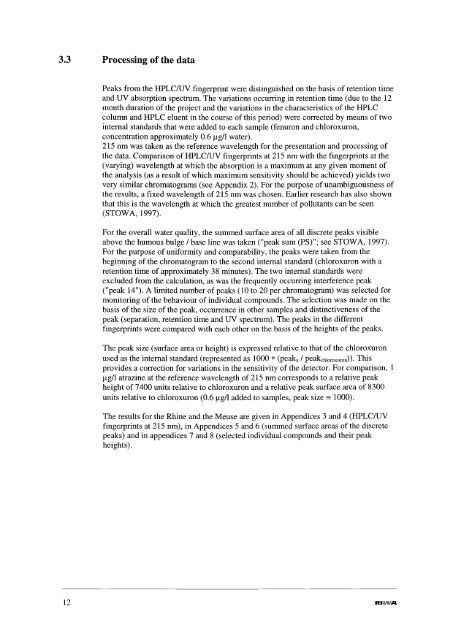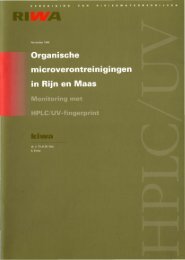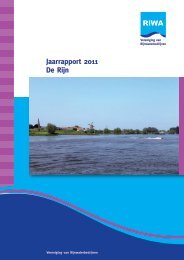Organic micropollutants in Rhine and Meuse a - Riwa
Organic micropollutants in Rhine and Meuse a - Riwa
Organic micropollutants in Rhine and Meuse a - Riwa
Create successful ePaper yourself
Turn your PDF publications into a flip-book with our unique Google optimized e-Paper software.
3.3 Process<strong>in</strong>g of the data<br />
Peaks from the HPLCIUV f<strong>in</strong>gerpr<strong>in</strong>t were dist<strong>in</strong>guished on the basis of retention time<br />
<strong>and</strong> UV absorption spectrum. The variations occurr<strong>in</strong>g <strong>in</strong> retention time (due to the 12<br />
month duration of the project <strong>and</strong> the variations <strong>in</strong> the characteristics of the HPLC<br />
column <strong>and</strong> HPLC eluent <strong>in</strong> the course of this period) were corrected by means of two<br />
<strong>in</strong>ternal st<strong>and</strong>ards that were added to each sample (fenuron <strong>and</strong> chloroxuron,<br />
concentration approximately 0.6 fIg/l water).<br />
215 nm was taken as the reference wavelength for the presentation <strong>and</strong> process<strong>in</strong>g of<br />
the data. Comparison of HPLC/UV f<strong>in</strong>gerpr<strong>in</strong>ts at 215 nm with the f<strong>in</strong>gerpr<strong>in</strong>ts at the<br />
(vary<strong>in</strong>g) wavelength at which the absorption is a maximum at any given moment of<br />
the analysis (as a result of which maximum sensitivity should be achieved) yields two<br />
very similar chromatograms (see Appendix 2). For the purpose of unambiguousness of<br />
the results, a fixed wavelength of 215 nm was chosen. Earlier research has also shown<br />
that this is the wavelength at which the greatest number of pollutants can be seen<br />
(STOWA, 1997).<br />
For the overall water quality, the summed surface area of all discrete peaks visible<br />
above the humous bulge / base l<strong>in</strong>e was taken ("peak sum (PS)"; see STOWA, 1997).<br />
For the purpose ofuniformity <strong>and</strong> comparability, the peaks were taken from the<br />
beg<strong>in</strong>n<strong>in</strong>g of the chromatogram to the second <strong>in</strong>ternal st<strong>and</strong>ard (chloroxuron with a<br />
retention time of approximately 38 m<strong>in</strong>utes). The two <strong>in</strong>ternal st<strong>and</strong>ards were<br />
excluded from the calculation, as was the frequently occurr<strong>in</strong>g <strong>in</strong>terference peak<br />
("peak 14"). A limited number of peaks (10 to 20 per chromatogram) was selected for<br />
monitor<strong>in</strong>g of the behaviour of <strong>in</strong>dividual compounds. The selection was made on the<br />
basis of the size of the peak, occurrence <strong>in</strong> other samples <strong>and</strong> dist<strong>in</strong>ctiveness of the<br />
peak (separation, retention time <strong>and</strong> UV spectrum). The peaks <strong>in</strong> the different<br />
f<strong>in</strong>gerpr<strong>in</strong>ts were compared with each other on the basis of the heights of the peaks.<br />
The peak size (surface area or height) is expressed relative to that of the chloroxuron<br />
used as the <strong>in</strong>ternal st<strong>and</strong>ard (represented as 1000 * (peakx/ peakchloroxuron)). This<br />
provides a correction for variations <strong>in</strong> the sensitivity of the detector. For comparison, 1<br />
fIg/1 atraz<strong>in</strong>e at the reference wavelength of 215 nm corresponds to a relative peak<br />
height of 7400 units relative to chloroxuron <strong>and</strong> a relative peak surface area of 8300<br />
units relative to chloroxuron (0.6 fIg/1 added to samples, peak size == 1000).<br />
The results for the Rh<strong>in</strong>e <strong>and</strong> the <strong>Meuse</strong> are given <strong>in</strong> Appendices 3 <strong>and</strong> 4 (HPLC/UV<br />
f<strong>in</strong>gerpr<strong>in</strong>ts at 215 nm), <strong>in</strong> Appendices 5 <strong>and</strong> 6 (summed surface areas of the discrete<br />
peaks) <strong>and</strong> <strong>in</strong> appendices 7 <strong>and</strong> 8 (selected <strong>in</strong>dividual compounds <strong>and</strong> their peak<br />
heights).<br />
12 RIMI'A













